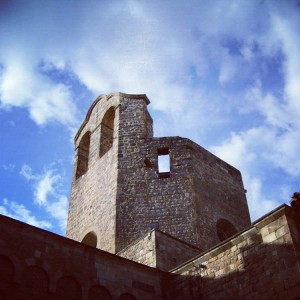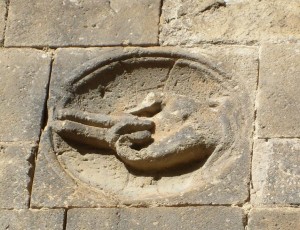Ley lines of Barcelona – the church of Sant Pau del Camp
It’s fair to say that the church of Sant Pau del Camp (Saint Paul of the Countryside) ranks pretty far down most visitors’ ‘to see in Barcelona’ lists, if it features at all. Sitting smack-bang in the middle of the long-beleagured Raval district, it struggles to hold its own in guide books that swoon over the beauty of Santa María del Mar and go weak at the knees over Gaudí’s magnum opus.
Which is a shame, because this little church, the oldest one in Barcelona, is something special.
I first discovered it one Sunday last year, arriving just as they were locking up. Despite the fact he was headed home for his Sunday lunch, Jordi greeted me with a huge smile and insisted on giving me a full guided tour that included him singing in Gregorian chant to illustrate the nave’s amazing acoustics. (I’ve since found out that Jordi is a former monk of the mountain-top monastery of Montserrat, which runs a prestigious school for choirboys.)
Emerging out into the rambunctiousness of the Raval and the harsh July sunlight, I kept trying to figure out why I felt so fascinated with the place. Sure, it’s a compelling mix of history, politics, religion and architecture – but aren’t loads of buildings in Barcelona?
Jordi remarks that some visitors come with divining rods, convinced there are mystical undercurrents at work, and points out that the building’s orientation to the east, land of sun and paradise lost, is slightly off-kilter. Were the monks into feng shui, he grins?
‘Ora y labora’ – pray and work
Although the official story is that the church was set up in the 10th century, according to Jordi the site had been the favoured spot of a monastic community since way back in the fourth. What is definite is that the Catalan count Guifré II set up a Benedictine order here at the end of the 9th century.
If you know your Catalan history, you’ll recognise this name. This Guifré is the son of Guifré el Pilós (Wilfred the Hairy to you and me), who’s something of a legend in these parts. He’s credited with being the founding father of Catalonia and the four-striped Catalan flag is said to have come about when a fellow fighter dipped his fingers in the dying Guifré’s blood. Look out for the tombstone of Guifré junior just off the cloister, dated AD 911.
Meanwhile, in the dusky garden to the side of the church you can just make out the remnants of stone foundations that were part of the original Benedictine monastery, destroyed by Muslim armies first in 985 and later again in 1114. (We also found a human bone under the palm trees, but we won’t dwell on that part.)
Into the 12th century, monastic life gets into the swing of things again, and Jordi tells me that there would have typically been around five to eight monks living and working within the convent. The narrow slit windows inside the main chapel, in trusty Romanesque style, barely let in any of the Barcelona sunlight, and Jordi says that in the Middle Ages these would have been made of translucent alabaster. Enough to illuminate the chapel slightly, but without admitting piercing solar rays that might have disturbed the monks at prayer.
Solar rays or not, I find myself getting easily distracted imagining the little community who lived in secret behind the thick stone walls. Seven times a day they came together to pray inside the church. I imagine the place must have been even more of a haven in those times than it is today, surrounded by the original fields and orchards that lend it its name. Nowadays, a cypress, olive and palm tree are the only sentinels left to stand guard around it.
A poem in stone
But even more captivating than picturing the lives of the monastery’s former inhabitants is the small, intimate cloister inside. The lobed arches support carved motifs that read like a who’s who from the worlds of nature and mythology – a Templar labyrinth of symbols that seem to taunt you with their ability to sit just beyond your understanding.
Adam and Eve clutch their throats, choking on an apple pip as a particularly bulbous serpent sniggers up a tree. Two toads gorge themselves on a woman’s breasts. A daisy, a wheel, a griffin and a school of sirens all take their place in the pantheon.
And it seems I’m not the only one to have been fascinated. A young man once stood here, recounts Jordi, transfixed by the Lombardian arches and sketching the shadows beyond. His name – Jordi pauses for effect – was Pablo Ruiz Picasso.
As we make our way back outside I ask after the rabbit I seem to remember seeing in the church’s little kitchen garden last year. Jordi leads me round the side, past the grave of a lady who spent her whole life tending the place and whose love of sweeping is immortalised in the broom still propped up faithfully next to her tombstone. Since I was last here the rabbit has apparently been joined by a chicken and four wayward puppies, who emerge as one giant tangle of tails and whose apparent mission in life is to torment chickens and rabbits.
It’s an exuberant expression of life in a place that’s ancient, stark and still, and I leave feeling like I’m stepping over some serious past-life ley lines.




 Guiri is one of those words, like feminist or peely-wally, that I want to reclaim. Locals use it to refer to tourists - you know the ones - who stick out a million miles. No matter how long I live in Barcelona, that's always going to be me. (P.S. While Barça locally refers to the football team, Brits use Barca as shorthand for the whole city.)
Guiri is one of those words, like feminist or peely-wally, that I want to reclaim. Locals use it to refer to tourists - you know the ones - who stick out a million miles. No matter how long I live in Barcelona, that's always going to be me. (P.S. While Barça locally refers to the football team, Brits use Barca as shorthand for the whole city.) 







Your own personal tour with Jordi. What a wonderful experience!
Es una joya, aquella iglesia.
It’s an amazing place, honestly, everyone should see it. The people who staff it are some of the warmest, decent human beings I’ve met in Barcelona.
If (when) I get back to Barcelona, I will definitely visit this place! Thanks for the great post.
Dan Burke recently posted..Power of the clave
Cheers Dan. Ask for Jordi when you get there (or phone in advance to make sure he’ll be there). Mention my name and he’ll give you the works:)